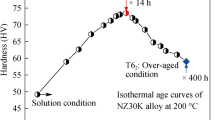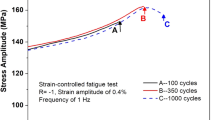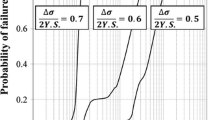Abstract
The high cycle fatigue (HCF) and cyclic crack growth rate (CCGR) properties of the dispersion strengthened ODS-alloy MA 6000 were investigated with smooth bars and with fracture mechanics samples at 850 °C. The material was very coarse grained with the grains elongated in the rolling direction. Fatigue crack initiation and crack propagation were studied parallel and perpendicular to the rolling direction and a pronounced influence of orientation was found. The fatigue limit of sam-ples cut parallel to the grain elongation direction (p-samples) was almost a factor of 2 higher than the one of samples cut transverse to the elongation direction (t-samples). Inclusions were found to be responsible for crack initiation. For p-samples a reasonable agreement between particle size, fatigue limit, and crack growth behavior was found. For t-type samples such an agreement also exists provided differences in the crack growth behavior of short cracks and long cracks are taken into consideration. The low fatigue strength of t-samples could be linked with low Young's modulus in this direction. The crack propagation rate of long cracks is lower in t-samples than in p-samples due to crack branching along the grain boundaries. HCF-strength of MA 6000 is high compared to conventional cast alloys mainly because of reduced size of crack nucleation sites and higher fatigue threshold stress intensity range ΔKth, as a result of higher Young's modulus.
Similar content being viewed by others
References
T. K. Glasgow: inA Collection of Technical Papers on Structures and Materials, Conf. Proc. St. Louis, MO, AIAA-ASME-ASCE-AMS, Paper Nr. 79-0763, 1979, p. 249.
Y. G. Kim and H. F. Merrick:Superalloys 1980, J. K. Tienet al., eds., ASM, Metals Park, OH, 1980, p. 551.
R.K. Hane and M.L. Wayman:Trans. TMS-AIME, 1967, vol. 239, p. 721.
J.R. Weber and M. Y. Bomford: inFatigue at Elevated Tempera- tures, ASTM STP 520, Carden, McEvily, and Wells, eds., ASTM, Philadelphia, PA, 1972 p. 427.
G. S. Hoppin and F. A. Schweizer: inFrontiers of High Temperature Materials, J. S. Benjamin, ed., IncoMAP, New York, NY, 1981, p. 75.
M. Y. Nazmy,R. F. Singer,andE. Török:Conf. Proc. the7th Int. Conf. on Textures of Materials, 17th–21st September 1984, Zwijndrecht, The Netherlands, to be published.
T. Howson, D. A. Mervyn, and J.K. Tien:Metall. Trans. A, 1980, vol. 11 A, p. 1609.
J.D. Whittenberger:Mater. Sci. Engg., 1982, vol. 54, p. 81.
Y.G. Kim and H.F. Merrick: NASA CR-159493, 1979.
R. F. Singer, W. Blum, and W. D. Nix:Scripta Met., 1980, vol. 14, p. 755.
R.F. Singer: BBC-Research Center, CH-5405 Baden, Switzerland, unpublished results, 1981.
J. Lankford, T. S. Cook, and G.P. Sheldon:Int. J. Fract., 1981, vol. 17, p. 143.
J.F. McCarverand R. O.Ritchie:Mat. Sci. Eng., 1982, vol. 55, p. 63.
W. Hoffeiner:Metall. Trans. A, 1982, vol. 13A, p. 1245.
M.O. Speidel: inHigh-Temperature Materials in Gas Turbines, P. R. Sahm and M. O. Speidel, eds., Elsevier Scientific Publ. Comp., 1974, p. 207.
Author information
Authors and Affiliations
Rights and permissions
About this article
Cite this article
Hoffelner, W., Singer, R.F. High-cycle fatigue properties of the ODS-alloy MA 6000 at 850 °C. Metall Trans A 16, 393–399 (1985). https://doi.org/10.1007/BF02814337
Received:
Issue Date:
DOI: https://doi.org/10.1007/BF02814337




